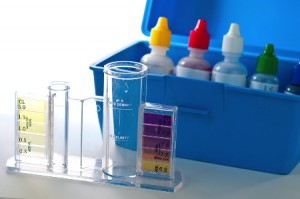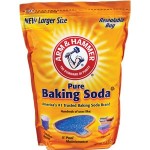Swimming Pool Chemistry
In nature, bodies of water exist in a state of balance. You can jump into most lakes on Earth and not have to worry about pH being too low. However, a swimming pool is a closed system. It needs to be maintained via artificial methods. There is where a lot of stress can be introduced in your life. There are so many products available at pool stores that you simply don’t know what to get. You end up using recommendation of the salesperson or do a google search to receive a million different recommendations. Some problems that I have encountered:
- Why isn’t shock removing the green?
- Why is the water cloudy?
- Why is the pH so high?
- Why do I have difficulty telling what shade of purple is on the test strip?
After 5 years of living with a pool, I have narrowed down its maintenance to the following 5 rules. Before you do anything, you must have a pool test kit (not the strips, but the ones with the drops).

pH Level
Ideal range: 7.2 to 7.6
You know what pH is from your high school classes, right? The trick to maintaining pH level is the use of two common chemicals:
pH is too low (below 7.2): raise pH by adding Soda Ash aka Washing Soda. This is just Sodium Carbonate – Na2CO3. You can buy this in bulk at either pool store or hardware store. Broadcast it into the water.
pH is too high (above 7.6): lower pH by adding Hydrochloric Acid (HCl). It is sold as Muriatic Acid which is just 40% HCl, 60% water. Be careful with this one – don’t splash or inhale the fumes!
Total Alkalinity
Ideal range: 80 ppm to 120 ppm

This is the measure of total dissolved alkaline substances in the water. It has a stabilizing effect, i.e. it prevents wild swings in pH levels.
TA is too low (below 80 ppm): raise TA by broadcasting baking soda in the pool. Yes, your humble Sodium bicarbonate – NaHCO3 will do the trick. You can buy a large bag of baking soda of the Arm and Hammer brand, if you’d like as they are easy to find.
TA is too high (above 120 ppm): well, this is tricky. I think you add acid until levels come down to 100 ppm. Please google this one!
Chlorine Level
Ideal range: 1 ppm to 3 ppm
Chlorine is what kills all those pesky microbes and algae in the water. In order for chlorine to work properly, it is essential that pH and Total Alkalinity are in the correct range. Otherwise you simply end up wasting money on Chlorine. For everyday use, I use the hockey puck size tablets – just drop a couple in the skimmer. If the pool shows signs of green, then you have to shock it which is essentially raising the Chlorine level to above 10 ppm. At these levels, pretty much any organic substance in the water is oxidized. I use liquid Chlorine. There are powdered varieties as well, but they include other ingredients which affect water chemistry in unknown (to me) ways. Always stick to simple chemistry!
Cyanuric Acid
Ideal range: 10 ppm to 50 ppm
Cyanuraic acid is responsible for making sure that the chlorine does not dissipate too fast. This is often an ingredient in chlorine tablets and is known as stabilizer. Generally not an issue. However:
Level is too low: your chlorine in the water will dissipate too quickly in sunlight.
Level is too high: chlorine will be released too slowly and will be ineffective.
Summary
That’s all there is to pool maintenance. You may need a clarifier in case your pool gets cloudy, but use it only after addressing all the parameters above and that pool is algae free. Regular maintenance tips:
- Run pump 5-8 hours per day.
- Clean filters once a week.
- Test chemistry once a week and make adjustments as needed.
- Enjoy!

